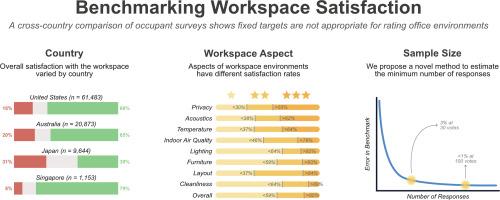Measuring what matters: A benchmarking system for occupant satisfaction with workspace environments
IF 7.6
1区 工程技术
Q1 CONSTRUCTION & BUILDING TECHNOLOGY
引用次数: 0
Abstract
Occupant satisfaction with the physical environment of the workplace is a key metric of office building performance. To date, no clear consensus exists on how to fairly compare satisfaction levels between buildings or benchmark workspace designs. This study analyses 93,153 Post-Occupancy Evaluation (POE) survey responses from the United States, Australia, Japan, and Singapore to identify systematic differences between countries and establish empirical benchmarks across key aspects of office workspaces. Results show that Singaporean offices achieve the highest overall workspace satisfaction (79%), followed by the United States (68%), Australia (65%) and Japan (39%). The United States and Australian databases display broadly comparable patterns across workspace aspects, with only minor differences in temperature, acoustics, and privacy. In contrast, significant differences are observed in the Japanese and Singaporean datasets compared with Western counterparts. Rather than applying a fixed performance target, such as the widely used 80% satisfaction rate, we propose empirically derived benchmarks based on the distribution of satisfaction rates observed in each survey. Performance levels are then categorized into a 3-star ranking, where 3 stars denotes the highest performance (above the 80th percentile) and 1 star the lowest (below the 30th percentile). This approach enables building rating schemes to assign credits more equitably and helps managers benchmark performance more effectively. The study also provides a method for determining the minimum sample size needed for representative POE survey results.

衡量什么是重要的:一个衡量居住者对工作环境满意度的基准系统
居住者对工作场所物理环境的满意度是办公楼性能的关键指标。到目前为止,对于如何公平地比较建筑物或基准工作空间设计之间的满意度水平,还没有明确的共识。本研究分析了来自美国、澳大利亚、日本和新加坡的93153份入住后评估(POE)调查反馈,以确定各国之间的系统性差异,并在办公空间的关键方面建立经验基准。结果显示,新加坡办公室的整体工作空间满意度最高(79%),其次是美国(68%)、澳大利亚(65%)和日本(39%)。美国和澳大利亚的数据库在工作空间方面显示出广泛的可比较模式,只有温度、声学和隐私方面的微小差异。相比之下,日本和新加坡的数据集与西方的数据集相比存在显著差异。我们没有采用固定的绩效目标,例如广泛使用的80%满意率,而是根据每次调查中观察到的满意度分布,提出了经验推导的基准。然后将绩效等级划分为3星级别,其中3星表示最高绩效(高于第80个百分位),1星表示最低绩效(低于第30个百分位)。这种方法使建立评级方案能够更公平地分配信用,并帮助管理人员更有效地对绩效进行基准测试。该研究还提供了确定代表性POE调查结果所需的最小样本量的方法。
本文章由计算机程序翻译,如有差异,请以英文原文为准。
求助全文
约1分钟内获得全文
求助全文
来源期刊

Building and Environment
工程技术-工程:环境
CiteScore
12.50
自引率
23.00%
发文量
1130
审稿时长
27 days
期刊介绍:
Building and Environment, an international journal, is dedicated to publishing original research papers, comprehensive review articles, editorials, and short communications in the fields of building science, urban physics, and human interaction with the indoor and outdoor built environment. The journal emphasizes innovative technologies and knowledge verified through measurement and analysis. It covers environmental performance across various spatial scales, from cities and communities to buildings and systems, fostering collaborative, multi-disciplinary research with broader significance.
 求助内容:
求助内容: 应助结果提醒方式:
应助结果提醒方式:


